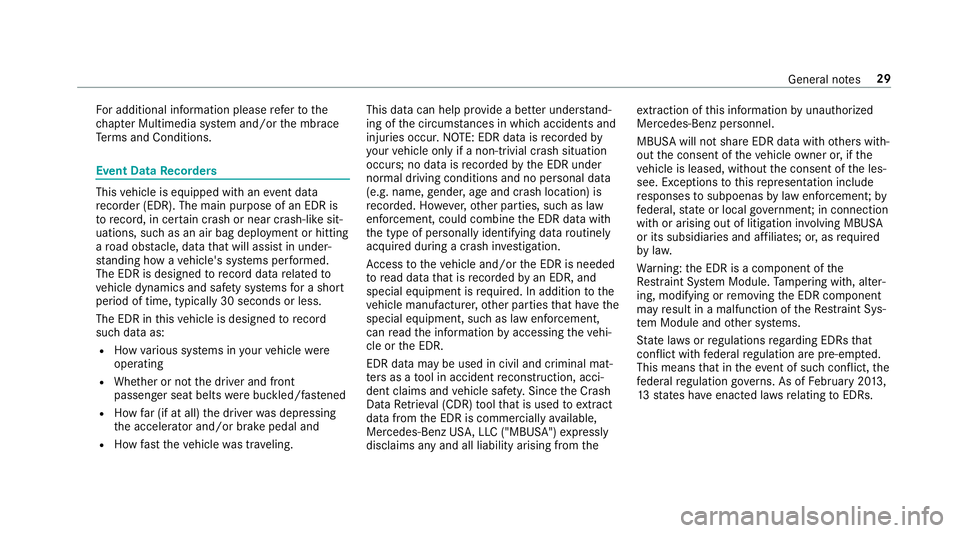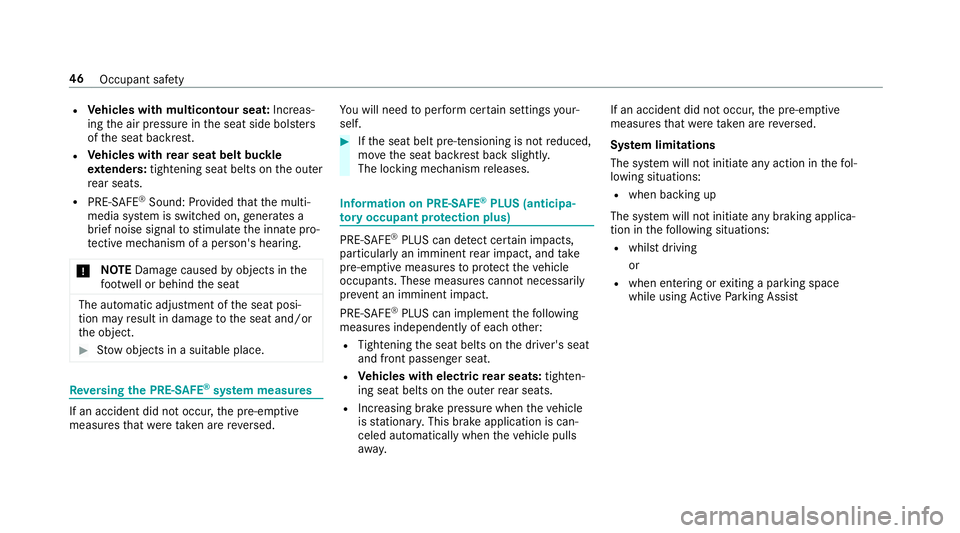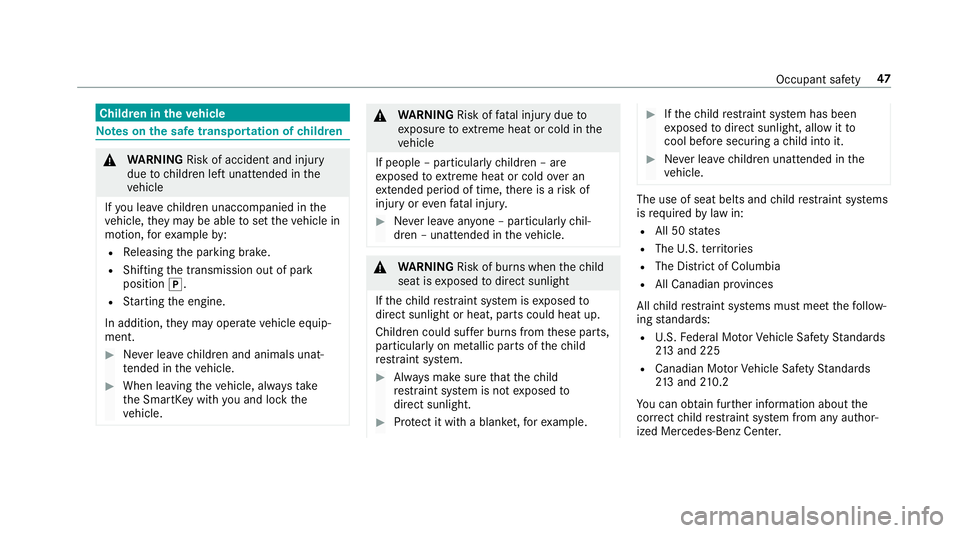2018 MERCEDES-BENZ S-CLASS SEDAN brake
[x] Cancel search: brakePage 9 of 562

1Steering wheel gearshift paddle →
176
2 Combination switch →
144
3 DIRECT SELECT le ver →
173
4 PASSENGER AIRB AGindicator lamps →
,, 43
5 Display (multimedia sy stem) →
269
6 Start/ Stop button →
166
7 Climat e control sy stems →
158
8 Glovebox →
120
9 Stow age compartment →
120
A Cup holder →
129
B Hazard warning lights →
145
C Extends the head restra ints of there ar seats →
102
D Parking Assist PARKTRONI C →
220
E Control elements forth e multimedia sy stem →
269
F Active Parking Assist →
228
G Sets theve hicle le vel →
213
H DYNA MIC SELECT switch →
173I
ECO start/ stop function →
171
J Control panel forth e multimedia sy stem →
245
K Adjusts thesteering wheel →
110
L Control panel for:
On-board computer →
245
Operating cruise contro l →
197
Operating Active Dis tance Assist DISTRONIC →
200
M Unloc ksthe hood →
378
N Electric pa rking brake →
185
O Light switch →
143
P Control panel for:
Ac tive Steering Assist →
206
Ac tive Lane Keeping Assist →
242
Night View Assist →
236
Head-up Display →
255
Re ar wind ow roller sunblind →
72
Ataglance – Cockpit 7
Page 11 of 562

1Speedom eter →
244
2 AIR BODY CONTROL malfunctioning →
511
3 #! Turn signal light →
144
4 Multifunction display →
247
5 Tach ome ter →
244
6 å ESP
®OFF →
503
÷ ESP
®→
503
7 K High beam →
144
L Low beam →
143
T Parking lights →
143
8 ? Coolant too hot/cold →
513
9 Coolant temp erature gauge →
244
A · Distance warning →
511
B Ð Steering assis tance malfunction →
512
C # Electrical malfunction →
513
D Brakes (red) →
503
$USA only
J Canada only
E ü Seat belt is not fastened →
510
F Fuel le vel indicator
G 8 Fuelreser vewith fuel filler flap location
indicator →
513
H R Rear fog light →
144
I 6 Restra int sy stem
J % Indicator lamp has no function
K ; Check Engine →
513
L J Brakes (yell ow) →
503
M Electric parking brake applied (red) →
503
F USA only
! Canada only
N h Tire pressure monitoring sy stem →
517
O ! ABS malfunction →
503
P ! Electric pa rking brake (yellow) →
503
Ataglance – Warning and indicator lamps 9
Page 22 of 562

*NO
TEImpairment of the operating ef fi‐
ciency of there stra int sy stems from
ins talling accessories or from repairs or
we lding
Airbags, Emer gency Tensioning Devices, as
we ll as control units and sensors forth e
re stra int sy stems, may be ins talled in thefo l‐
lowing areas of your vehicle:
RDoors
RDoor pillars
RDoor sills
RSeats
RCo ckpit
RInstrument clus ter
RCente r console
#Do not ins tall accessories such as audio
sy stems in these areas.
#Do not car ryout repairs or welding.
#Have accessori esretrofitted at a quali‐
fi ed specialist workshop.
Yo u could jeopardize the operating saf etyof your
ve hicle if you use parts, tires and wheels as well
as accessories releva nt tosaf etywhic hha ve not
been appr ovedby Mercedes-Benz. Saf ety-re le‐
va nt sy stems, e.g. the brake sy stem, may mal‐
function. Only use Mercedes-Benz GenuineParts
or parts of equal quality. Only use tires, wheels
and accessory parts that ha vebeen specifically
appr ovedfo ryo ur vehicle model.
Mercedes-Benz GenuineParts are subject to
st rict quality control. Each part has been spe‐
cially de veloped, manufactured or selecte dfo r
Mercedes-Benz vehicles and fine-tuned forth em.
Therefore, only Mercedes-Benz GenuineParts
should be used.
More than 300,000 dif fere nt Mercedes-Benz
GenuineParts are available for Mercedes-Benz
models.
All au thorized Mercedes-Benz Centers maintain
a supply of Mercedes-Benz GenuineParts for
necessary service and repair work. In addition,
st ra tegically located parts-delivery centers pro‐
vide forqu ick and reliable parts service. Alw
ays specify theve hicle identification number
(VIN) (→page 445) when orde ring Mercedes-
Benz GenuineParts.
Ope rato r's Manual
This Operator's Manual describes all models and
all standard and optional equipment available for
yo ur vehicle at the time of this Opera tor's Man‐
ual going topress. Countr y-specific dif fere nces
are possible. No tethat your vehicle may not be
equipped with all features descri bed. This also
applies tosaf ety-re leva nt sy stems and functions.
Therefore, the equipment on your vehicle may
dif fer from that in the descriptions and illustra‐
tions.
The original pur chase contract documentation
fo ryo ur vehicle contains a list of all of the sys‐
te ms in your vehicle.
Should you ha veany questions concerning
equipment and operation, please consult an
authorized Mercedes-Benz Center.
The Operator's Manual and Maintenance Booklet
are impor tant documents and should be kept in
th eve hicle.
20
General no tes
Page 29 of 562

Rstatus messages concerning theve hicle and
its individual components (e.g. number of
wheel revo lutions/speed, decele ration, lat‐
eral acceleration, display of thefast ened seat
belts)
Rmalfunctions or defects in impor tant sy stem
components (e.g. lights, brakes)
Rinformation on vehicle damage events
Rsystem reactions in special driving situations
(e.g. air bag deployment, inter vention of sta‐
bility control sy stems)
Rambient conditions (e.g. temp erature, rain
sensor)
In addition toprov iding the actual control unit
function, this data assists the manufacturer in
de tecting and rectifying malfunctions and opti‐
mizing vehicle functions. The majority of this
data is temp orary and is only processed in the
ve hicle itself. Only a small portion of the data is
st ored in theev ent or malfunction memor y.
When your vehicle is serviced, tech nical da ta
from theve hicle can be read out byservice net‐
wo rkemplo yees or third parties. Services
include repair services, maintenance processes, wa
rranty events and quality assurance meas‐
ures, forex ample. The read out is per form ed via
th e legally prescribed port for OBD ("on-board
diagnostics") in theve hicle. The respective
service network locations or third parties col‐
lect, process and use the data. They document
te ch nical statuses of theve hicle, assist in
find
‐
ing malfunctions and impr oving quality and are
transmitte dto the manufacturer, if necessar y.
Fu rthermore, the manufacturer is subject to
product liability. Forth is, the manufacturer
re qu ires tech nical da tafrom vehicles.
Malfunction memories in theve hicle can be
re set bya service outlet as part of repair or
maintenance work.
They can enter data into theve hicle's con veni‐
ence and inf otainment functions themselves as
part of the selected equipment.
This includes, forex ample:
Rmultimedia data such as music, films or pho‐
to sfo r playba ckin an integrated multimedia
sy stem
Raddress book data for use in connection with
an integrated hands-free sy stem or an inte‐
grated navigation sy stem
Rentered navigation destinations
Rdata about the use of Internet services
This data can be stored locally in theve hicle or
is located on a device which you ha veconnected
to theve hicle. If this data is stored in theve hi‐
cle, you can dele teit at any time. This data can
only be transmitte dto third parties upon your
re qu est with particular rega rd tothe scope of
use of online services according to your selected
settings.
Yo u can store or change con venience settings/
individualization in theve hicle at any time.
Depending on the eq uipment,
this in
cludes,for
ex ample:
Rseat and steering wheel position settings
Rsuspension and climate control settings
Rindividualization such as interior lighting
If yo ur vehicle is accordingly equipped, you can
connect your smartphone or ano ther mobile end
General no tes 27
Page 31 of 562

For additional information please referto the
ch ap ter Multimedia sy stem and/or the mbrace
Te rm s and Conditions.
Event Data Recorders
This vehicle is equipped with an event data
re corder (EDR). The main purp ose of an EDR is
to record, in cer tain crash or near crash-like sit‐
uations, such as an air bag deployment or hitting
a ro ad obs tacle, data that will assist in under‐
st anding how a vehicle's sy stems per form ed.
The EDR is designed torecord data related to
ve hicle dynamics and saf etysy stems for a short
period of time, typically 30 seconds or less.
The EDR in this vehicle is designed torecord
such data as:
RHowvarious sy stems in your vehicle were
operating
RWhe ther or not the driver and front
passenger seat belts werebuckled/fas tened
RHow far (if at all) the driver was depressing
th e accelera tor and/or brake pedal and
RHow fasttheve hicle was tr aveling. This data can help pr
ovide a better under stand‐
ing of the circums tances in which accidents and
inju ries occur. NOTE: EDR data is recorded by
yo ur vehicle only if a non-trivial crash situation
occurs; no data is recorded bythe EDR under
normal driving conditions and no personal data
(e.g. name, gende r,age and crash location) is
re corded. Ho wever,ot her parties, such as law
enforcement, could combine the EDR data with
th e type of personally identifying data routinely
acquired during a crash inve stigation.
Ac cess tothe
ve hicle and/or the E
DR is needed
to read data that is recorded byan EDR, and
special equipment is required. In addition tothe
ve hicle manufacturer, other parties that ha vethe
special equipment, such as law enforcement,
can read the information byaccessing theve hi‐
cle or the EDR.
EDR data may be used in civil and criminal mat‐
te rs as a tool in accident reconstruction, acci‐
dent claims and vehicle saf ety. Since the Crash
Data Retrie val (CDR) tool that is used toextract
da ta from the EDR is commercially available,
Mercedes-Benz US A,LLC ("MBUSA") expressly
disclaims any and all liability arising from the ex
traction of this information byunauthorized
Mercedes-Benz personnel.
MBUSA will not share EDR data withot hers with‐
out the consent of theve hicle owner or, if the
ve hicle is leased, without the consent of the les‐
see. Exceptions tothis representation include
re sponses tosubpoenas bylaw enforcement; by
fe deral, state or local go vernment; in connection
with or arising out of litigation in volvin g MBUSA
or its subsidiari es and affiliates; or, as requ ired
by law.
Wa rning: the EDR is a component of the
Re stra int Sy stem Module. Tamp ering with, alter‐
ing, modifying or removing the EDR component
may result in a malfunction of theRe
stra in
t Sys‐
te m Module and other sy stems.
St ate la wsorregulations rega rding EDRs that
con flict with federal regulation are pre-em pted.
This means that in theeve nt of such conflict,the
fe deral regulation go verns. As of February 20 13,
13 states ha veenacted la wsrelating toEDRs.
General no tes 29
Page 48 of 562

RVehicles with multicontour seat: Increas‐
ing the air pressure in the seat side bols ters
of the seat backrest.
RVe hicles with rear seat belt buckle
ex tenders: tightening seat belts on the outer
re ar seats.
RPRE- SAFE®Sound: Pr ovided that the multi‐
media sy stem is switched on, generates a
brief noise signal tostimulate the innate pro‐
te ctive mechanism of a person's heari ng.
* NO
TEDama gecaused byobjects in the
fo ot we ll or behind the seat
The automatic adjustment of the seat posi‐
tion may result in damage tothe seat and/or
th e object.
#St ow objects in a suitable place.
Reversing the PRE- SAFE®system measures
If an accident did not occur, the pre-em ptive
measures that we retak en are reve rsed. Yo
uwill need toper form certain settings your‐
self.
#If th e seat belt pre-tensioning is not reduced,
mo vethe seat backrest back slightl y.
The locking mechanism releases.
Information on PRE- SAFE®PLUS (anticipa‐
to ry occupant pr otection plus)
PRE- SAFE®PLUS can de tect cer tain impacts,
particular lyan imminent rear impact, and take
pre-em ptive measures toprotect theve hicle
occupants. These measures cannot necessarily
pr eve nt an imminent impact.
PRE-SAFE
®PLUS can implement thefo llowing
measures independently of each other:
RTightening the seat belts on the driver's seat
and front passenger seat.
RVe hicles with electric rear seats: tighten‐
ing seat belts on the outer rear seats.
RIncreasing brake pressure when theve hicle
is stationar y.This brake application is can‐
celed automatically when theve hicle pulls
aw ay. If an accident did not occur,
the pre-em ptive
measures that we retake n are reve rsed.
Sy stem limitations
The sy stem will not initiate any action in thefo l‐
lowing situations:
Rwhen backing up
The sy stem will not initiate any braking applica‐
tion in thefo llowing situations:
Rwhilst driving
or
Rwhen entering or exiting a parking space
while using Active Parking Assist
46
Occupant saf ety
Page 49 of 562

Children in theve hicle
Note s onthe safe transportation of children
&
WARNING Risk of accident and injury
due tochildren left unatte nded inthe
ve hicle
If yo u lea vechildren unaccompanied in the
ve hicle, they may be able toset theve hicle in
motion, forex ample by:
RRe leasing the parking brake.
RShifting the transmission out of park
position j.
RStarting the engine.
In addition, they may operate vehicle equip‐
ment.
#Ne ver lea vechildren and animals unat‐
te nded in theve hicle.
#When leaving theve hicle, alw aysta ke
th e SmartK eywith you and lock the
ve hicle.
&
WARNING Risk offata l injury due to
ex posure toextreme heat or cold in the
ve hicle
If people – particularly children – are
ex posed toextreme heat or cold over an
ex tended pe riod of time, there is a risk of
injury or evenfa ta l injur y.
#Never lea veanyone – pa rticularly chil‐
dren – unatte nded intheve hicle.
&
WARNING Risk of burn s whenthech ild
seat is exposed todirect sunlight
If th ech ild restra int sy stem is exposed to
direct sunlight or heat, parts could heat up.
Children could suf fer burns from these parts,
particularly on me tallic parts of thech ild
re stra int sy stem.
#Alw ays make sure that thech ild
re stra int sy stem is not exposed to
direct sunlight.
#Pr otect it with a blank et,fo rex ample.
#Ifth ech ild restra int sy stem has been
ex posed todirect sunlight, allow it to
cool before securi ng achild into it.
#Ne ver lea vechildren unatte nded inthe
ve hicle.
The use of seat belts and child restra int sy stems
is requ ired bylaw in:
RAll 50 states
RThe U.S. territories
RThe District of Columbia
RAll Canadian pr ovinces
All child restra int sy stems must meet thefo llow‐
ing standards:
RU. S. Federal Mo torVe hicle Saf etySt andards
21 3 and 225
RCanadian Mo torVe hicle Saf etySt andards
21 3 and 210.2
Yo u can obtain fur ther information about the
cor rect child restra int sy stem from any author‐
ized Mercedes-Benz Center.
Occupant saf ety 47
Page 57 of 562

Child safety loc ks
Activating/deactivating the child saf ety lock
fo r the rear doors
&
WARNING Risk of accident and injury
due tochildren left unatte nded inthe
ve hicle
If yo u lea vechildren unaccompanied in the
ve hicle, they may be able toset theve hicle in
motion, forex ample by:
RRe leasing the parking brake.
RShifting the transmission out of park
position j.
RStarting the engine.
In addition, they may operate vehicle equip‐
ment.
#Ne ver lea vechildren and animals unat‐
te nded in theve hicle.
#When leaving theve hicle, alw aysta ke
th e SmartK eywith you and lock the
ve hicle.
&
WARNING Risk offata l injury due to
ex posure toextreme heat or cold in the
ve hicle
If people – particularly children – are
ex posed toextreme heat or cold over an
ex tended pe riod of time, there is a risk of
injury or evenfa ta l injur y.
#Never lea veanyone – pa rticularly chil‐
dren – unatte nded intheve hicle.
&
WARNING Thereis arisk of accident
and injury if you lea vechildren unatte n‐
ded in theve hicle
If ch ildren are tra veling in theve hicle, they
could:
ROpen doo rs,th ereby endangering other
persons or road users.
RGet out of theve hicle and be hit by
oncoming traf fic.
ROpe rate ve hicle equipment and become
trapped, forex ample.
#Alw ays activate thech ild saf etyloc ks
av ailable if children are tra veling in the
ve hicle.
#Ne ver lea vechildren unatte nded inthe
ve hicle.
#When leaving theve hicle, alw aysta ke
th e SmartK eywith you and lock the
ve hicle.
Child saf etyloc ksare available forth ere ar doors
and forth ere ar side wind ows.
The child saf etyloc kon there ar doors secures
each door separatel y.The doors can no longer
be opened from the inside.
Occupant saf ety 55